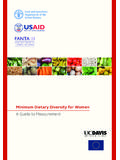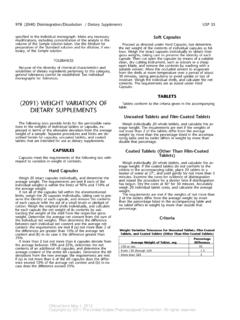Transcription of Nutrition Background Paper to inform the …
1 1 Final Version Nutrition Background Paper to inform the preparation of the 7th Five Year Plan This Paper was prepared with significant contributions from Dr. AM Zakir Hussain, Professor MQK Talukder*, Dr. Tahmeed Ahmed in close consultations with representatives of the Institute of Public Health Nutrition , the Ministry of Health and Family Welfare, the Food Planning and Monitoring Unit of the Ministry of Food, development partner representatives including the Canadian Department of Foreign Affairs, Trade and Development (DFTD), the Delegation of the European Union (EU), the United Kingdom Department of International Development (DFID), the United States Agency for International Development (USAID), the World Bank, and the United Nations Renewed Efforts Against Child Hunger and Undernutrition (UN REACH) agencies FAO, Unicef, WFP and WHO. February 2015 * Note: Professor MQK Talukder insisted that the private sector be excluded from Nutrition policy formulation and programmes.
2 2 CONTENTS Page Acronyms 3 Executive Summary 5 CHAPTER 1: INTRODUCTION 8 Why Nutrition is important 8 National and international commitments to scale up Nutrition 9 A conceptual framework for Nutrition 10 CHAPTER 2: CURRENT Nutrition SCENARIO 12 Under 5 children nutritional status and early childhood development 12 Nutritional status of girls and women, and links to gender inequality 13 Micronutrient deficiencies 14 Overweight, obesity and Nutrition related NCDs 14 Food diversity and dietary habits as determinants of Nutrition 15 IYCF and care practices as determinants of Nutrition and early childhood development 16 Access to health services as determinant of Nutrition 17 Access to clean environment as determinant of Nutrition 17 Poverty, and other inequities, related to Nutrition 18 Stewardship for Nutrition policy, plans and governance 20 CHAPTER 3: Nutrition IN THE 6th FIVE YEAR PLAN 24 Nutrition -specific mechanisms and interventions 24 Nutrition -sensitive mechanisms and interventions 26 The broader context for Nutrition under the 6th Five Year Plan 27 CHAPTER 4: ISSUES AND CHALLENGES 28 Institutions, coordination and capacity for Nutrition 28 Nutrition -specific solutions 29 Nutrition -sensitive solutions 31 CHAPTER 5: DEVELOPMENT VISION FOR Nutrition IN 7th FYP 33 Vision, goals and objectives 33 Strategies 33 CHAPTER 6: RECOMMENDATIONS 44 References 51 Tables 1.
3 Prevalence of micronutrient deficiencies 2. Trends in food consumption, 1991-2010 3. Existing coordination mechanisms for Nutrition in the health and food sectors 4. Proposed organogram for Multisectoral and Multitakeholder Nutrition Coordination and Governance Mechanism (BNNC) 14 15 23 34 Figures 1. Conceptual framework for Nutrition 2. Trends in prevalence of child (0-59 months) undernutrition: 1986-2013 3. Trends in overweight and underweight in women 4. Trends in breastfeeding indicators, 1993-2013 5. Map showing stunting rates by upazila 11 11 13 16 19 6. Proposed multistakeholder Nutrition coordination and governance mechanism 44 7 Proposed management structure for MoHFW and NNS 46 8. Multisectoral Nutrition governance at different levels 47 Annex National Nutrition Situation Analysis 2014 (compiled by UN REACH) 3 ACRONYMS ADP Annual Development Programme ICN International Conference on Nutrition AHI Assistant Health Inspector IDD Iodine Deficiency Disorder APR Annual Programme Review IEC Information Education and Communication APIR Annual Programme Implementation Report IEDCR Institute of Epidemiology Disease Control & Research APSU Agriculture Policy Support Unit IFAD Institute of Food and Agriculture Development BADC Bangladesh Agricultural Development Corporation IFPRI International Food Policy Research Institute BANHRDB Bangladesh Applied Nutrition & Human Resource Development Board IPH Institute of Public Health BARC Bangladesh Agricultural Research Council IPHN Institute of Public Health and Nutrition BARI Bangladesh Agriculture Research Institute ILO International Labour Organization BBF Bangladesh Breastfeeding Foundation IMCI Integrated Management of Childhood Infection BBS Bangladesh Bureau of Statistics IMED Implementation Monitoring and Evaluation
4 Division BCC Behaviour Change Communication IFNS Institute of Food and Nutrition Science BDHS Bangladesh Demographic and Health Survey INGO International Non-Government Organization MEAN Building Equity in Agriculture and Markets IT Information Technology BHE Bureau of Health Education IYCF Infant and Young Child Feeding BIDS Bangladesh Institute of Development Studies KAP Knowledge Attitude and Practice BINP Bangladesh Integrated Nutrition Project Kcal Kilo Calorie BIRDEM Bangladesh Institute of Research on Diabetic & Endocrine Metabolism LBW Low Birth Weight BIRTAN Bangladesh Institute of Research and Training on Applied Nutrition LD Line Director BNNC Bangladesh National Nutrition Council LGD Local Government Division BMI Body Mass Index LMIC Low and Middle Income Country BMS Breast Milk Substitutes MAD Minimum Acceptable Diet BRAC Bangladesh Rural Advancement Committee MAM Moderate Acute Malnutrition BRRI Bangladesh Rice Research Institute MCH Maternal and Child Health CARE Cooperative for American Relief Everywhere MDG Millennium Development Goal CBHC Community Based Health Care MICS Multiple Indicator Cluster Survey CBO Community Based Organization MMT Million metric tons CC Community Clinics MMR Maternal Mortality Rate CDC Centre for Disease Control and Prevention MN Micronutrient CG Community Support Group MNP Micro-nutrient Promotion CIP Country Investment Plan.
5 MNCAH Maternal Neonatal Child and Adult Health CMAM Community Managed Acute Malnutrition MoAg Ministry of Agriculture CNP Community Nutrition Promoter MoHFW Ministry of Health and Family Welfare CO2 Carbon-di-oxide MoLGRD&C Ministry of Local Government Rural Development & Cooperatives CRF Common Results Framework MoWCA Ministry of Women and Children Affairs CS Civil Surgeon MoSocWel Ministry of Social Welfare CSG Community Support Group MTR Mid-term Review C-section Caesarean Section MUAC Mid Upper Arm Circumference CSO Civil Society Organizations NAEP National Agricultural Extension Policy 4 DC Disease Control NCHS National Centre for Health Statistics DDT Dichlorodiphenyltrichloroethane NFP National Food Policy DfID Department for International Development (UK) NFP PoA National Food Policy Plan of Action DGFP Directorate General of Family Planning NGOs Non-Governmental Organizations DGHS Directorate General of Health Services NICC Nutrition Implementation Coordination Committee DP Development Partners NIPU Nutrition Information and Planning Unit DPE Department of Primary Education NPNL Non Pregnant Non Lactating DPM Deputy Programme Manager NNP National Nutrition Programme EBR Exclusive Breastfeeding Rate NNS National Nutrition Services EC Executive Summary NSSS National Social Safety (Protection)
6 Strategy EPI Expanded Programme on Immunization NPAN National Plan of Action for Nutrition ERD External Relations Division OP Operational Plan ESD Essential Service Delivery PLW Pregnant and Lactating Women FAO Food and Agriculture Organization PMMU Programme Management and Monitoring Unit FCT Food Composition Table PoA Plan of Action FDS Food Based Dietary Survey PM Programme Manager FPI Family Planning Inspector PPM Parts per million FPMC Food Planning and Monitoring Committee PRSP Poverty Reduction Strategy Paper FPMIS Food Planning and Monitoring Information System PW Planning Wing FPMU Food Planning and Monitoring Unit R&D Research and Development FPWG Food Policy Working Group SAARC South Asian Association of Regional Cooperation FSNIS Food Security Nutrition Information System SACMO Sub-assistant Community Medical Officer FSNSP Food Security Nutritional Surveillance Programme SAM Severe Acute Malnutrition FWA Family Welfare Assistant SCNI Steering Committee for Nutrition Implementation FYP Five Year Plan SDG Sustainable Development Goal GDP Gross Domestic Product SUN Scaling Up Nutrition GED General Economics Division UFPO Upazila Family Planning Officer GMP Growth Monitoring and Promotion UHFPO Upazila Health and Family Planning Officer GNI Gross National Income UN United Nations GNP Gross National Product UNDP United Nation Development Partner GoB Government of Bangladesh UNICEF United Nations Children's Fund GRID Groups and Inequality Data Base UPHCSDP Urban Primary Health Care Service Delivery Project HA Health Assistant USAID United states Agency for International Development HFI Household Food Insecurity USDA United States Dietary Advice HFWC Health and Family Welfare Centre VGD Vulnerable Group Development HI Health Inspector WASH Water Sanitation and Health HIES Household Income and Expenditure Survey WFP World Food Programme HMIS Health Management Information System WHO World
7 Health Organization HPNSDP Health, Population and Nutrition Sector Development Programme WHA World Health Assembly HPNSP Health, Population and Nutrition Sector Programme WHO World Health Organization ICDDRB International Centre for Diarrhoeal Diseases Research, Bangladesh 5 EXECUTIVE SUMMARY Nutrition is the best buy for economic development Sustained productivity, growth and prosperity for all people in Bangladesh will depend on concerted action to reduce malnutrition. The 2012 Copenhagen Consensus findings of Nobel Laureates and world-renowned economists and researchers concluded that undernutrition should be the top priority for policy makers because it is the best buy for development. The benefit-cost ratios from investing in Nutrition are highly competitive with investments in roads, irrigation, and health. Every $1 spent on improving Nutrition can have a $30 return on investment1. The high cost of the double burden of malnutrition: Bangladesh is now experiencing a high burden of undernutrition, to which a rapidly increasing burden of non-communicable diseases driven by overweight and obesity (known as Nutrition -related NCDs) is being added.
8 Despite a significant reduction in undernutrition over the last 20 years, driven partly by sustained income growth and partly by greater coverage of health and education services, undernutrition levels still remain very high. Any further progress is also unlikely to be achieved without a significant change in the level and scope of current investment for Nutrition , as well as the quality of Nutrition governance and service delivery. Undernutrition already costs Bangladesh more than 7,000 crore taka (US$1 billion) in lost productivity every year, and even more in health costs2. Persisting high levels of undernutrition, combined with rising levels of Nutrition -related NCDs, will only add to this economic cost, dampening potential growth and draining national resources. Concerted prioritised action on Nutrition in the 7th Five Year Plan (FYP) period will ensure that Bangladesh reaches middle-income country status quickly, and built on solid foundations.
9 Nutrition status in the country and progress to date During the 6th FYP period, there has been unprecedented growth in global attention to undernutrition, recognizing that Nutrition indicators have failed to improve in many countries in line with other development indicators. While national progress in reducing childhood stunting rates (from 71% in 1986 to 41% in 20113 and an estimated 37% in 20134) stands out as a global success story5, there is no room for complacency: Bangladesh is still classified as having a high prevalence of chronic undernutrition, and over six million children (2014 Census projection) are stunted. Progress on many Nutrition indicators, including infant and young child feeding practices (IYCF), has been slow or is stagnating. Early initiation of breastfeeding and exclusive breastfeeding rates under six months of age have remained at about 45% in the past 20 years, using surveillance data6, while BDHS 2011 reports the exclusive breastfeeding rate as 64%.
10 Less than two-fifths of children under 2 years of age received a minimum acceptable diet and 59% of women nationally do not consume an adequately diverse diet7. Three quarters of the population do not practice recommended hygiene behaviours. The proportion of overweight women (37%) is now more than double that of underweight women (18%). NCDs account for about 60% of all deaths, with cardiovascular and circulatory disease at 17%, and cancers at 24%8. Commitments to Nutrition Article 18 (1) in the Constitution of Bangladesh declares the State shall regard the raising of the level of Nutrition and improvement of public health as among its primary duties . Four decades after liberation, this duty has yet to be fulfilled. The 6th FYP (2011-2015) prioritized a number of significant actions on Nutrition , notably the mainstreaming of Nutrition services within the national health sector programme (HPNSDP, 2011-2016). However, this did not sufficiently acknowledge the multisectoral nature of the problem, nor recognise Nutrition s wider role in sustaining national productivity growth.






